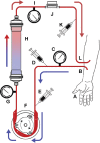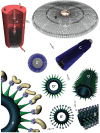A prospective treatment for sepsis
- PMID: 26005330
- PMCID: PMC4427604
- DOI: 10.2147/DDDT.S82755
A prospective treatment for sepsis
Abstract
The present paper proposes a prospective auxiliary treatment for sepsis. There exists no record in the published media on the subject. As an auxiliary therapy, efficacious extracorporeal removal of sepsis-causing bacterial antigens and their toxins (BATs) from the blood of septic patients is discussed. The principal component to this approach is a bacterial polyvalent antibody-column (BPVAC), which selectively traps wide spectrum of BATs from blood in an extracorporeal circuit, and detoxified blood returns back to the patient's body. BPVAC treatment would be a device of targeted medicine. Detoxification is performed under supervision of trained personnel using simple blood-circulating machines in which blood circulates from the patient to BPVAC and back to the patient aseptically. BPVACs' reactive sites consist of carbon nanotubes on which a vast spectra of polyvalent BATs-antibodies are bond to. The devise acts as a biological filter that selectively immobilizes harmful BATs from intoxicated blood; however, no dialysis is involved. For effective neutralization, BPVAC provides large contact surface area with blood. BPVAC approach would have advantages of: 1) urgent neutralization of notorious BATs from blood of septic patients; 2) applicability in parallel with conventional treatments; 3) potential to minimize side effects of the malady; 4) applicability for a vast range of BATs; 5) potential to eliminate contact of BATs with internal tissues and organs; 6) tolerability by patients sensitive to antiserum injections; 7) capability for universal application; 8) affectivity when antibiotic-resistant bacteria are involved and the physician has no or limited access to appropriate antibiotics; and 10) being a single-use, disposable, and stand-alone device. Before using it for clinical trials in human beings, it should pass animal evaluations accurately; however, research works should optimize its implementation in human beings. For optimization, it needs appropriate investments, collaboration of scientists in many fields of research, and development through several interdisciplinary sciences such as medical engineering, nanotechnology, immunology, biochemistry, emergency medicine, internal, and infectious diseases.
Keywords: antibiotic; blood; detoxification; infection; polyvalent antibody; targeted medicine.
Figures


Similar articles
-
Antiviral therapy: a perspective.Drug Des Devel Ther. 2016 Feb 2;10:541-6. doi: 10.2147/DDDT.S83037. eCollection 2016. Drug Des Devel Ther. 2016. PMID: 26893542 Free PMC article.
-
Design of a new therapy to treat snake envenomation.Drug Des Devel Ther. 2014 Jun 18;8:819-25. doi: 10.2147/DDDT.S65395. eCollection 2014. Drug Des Devel Ther. 2014. PMID: 24971000 Free PMC article.
-
Sepsis Care Pathway 2019.Qatar Med J. 2019 Nov 7;2019(2):4. doi: 10.5339/qmj.2019.qccc.4. eCollection 2019. Qatar Med J. 2019. PMID: 31763206 Free PMC article.
-
[Development of antituberculous drugs: current status and future prospects].Kekkaku. 2006 Dec;81(12):753-74. Kekkaku. 2006. PMID: 17240921 Review. Japanese.
-
Non-antibiotic strategies for sepsis.Clin Microbiol Infect. 2009 Apr;15(4):302-7. doi: 10.1111/j.1469-0691.2009.02753.x. Clin Microbiol Infect. 2009. PMID: 19416301 Review.
Cited by
-
Sepsis Management in Southeast Asia: A Review and Clinical Experience.J Clin Med. 2022 Jun 23;11(13):3635. doi: 10.3390/jcm11133635. J Clin Med. 2022. PMID: 35806919 Free PMC article. Review.
-
Antiviral therapy: a perspective.Drug Des Devel Ther. 2016 Feb 2;10:541-6. doi: 10.2147/DDDT.S83037. eCollection 2016. Drug Des Devel Ther. 2016. PMID: 26893542 Free PMC article.
References
-
- Gaieski DF, Edwards JM, Kallan MJ, Carr BG. Benchmarking the incidence and mortality of severe sepsis in the United States. Crit Care Med. 2013;41(5):1167–1174. - PubMed
-
- Kaukonen KM, Bailey M, Suzuki S, Pilcher D, Bellomo R. Mortality related to severe sepsis and septic shock among critically ill patients in Australia and New Zealand, 2000–2012. JAMA. 2014;311(13):1308–1316. - PubMed
-
- World-sepsis-day.org World sepsis declaration. [Accessed October 1, 2014]. 2015. Available from: http://www.world-sepsis-day.org/?MET=SHOWCONTAINER&vCONTAINERID=489.
-
- U.S. National Library of Medicine Acute respiratory distress syndrome. [Accessed October 1, 2014]. 2015. Available from: http://www.ncbi.nlm.nih.gov/pubmedhealth/PMH0001164/
-
- Johns Hopkins Medicine, Health Library Septicemia. [Accessed October 1, 2014]. Available from: http://www.hopkinsmedicine.org/healthlibrary/conditions/adult/nervous_sy...
MeSH terms
Substances
LinkOut - more resources
Full Text Sources
Medical
Research Materials

